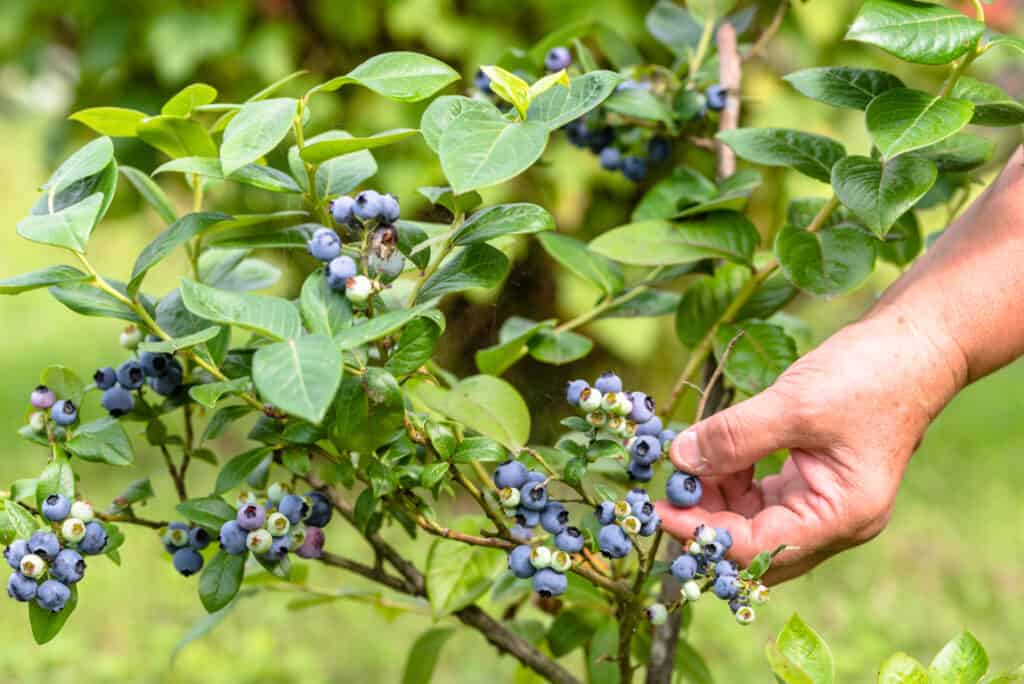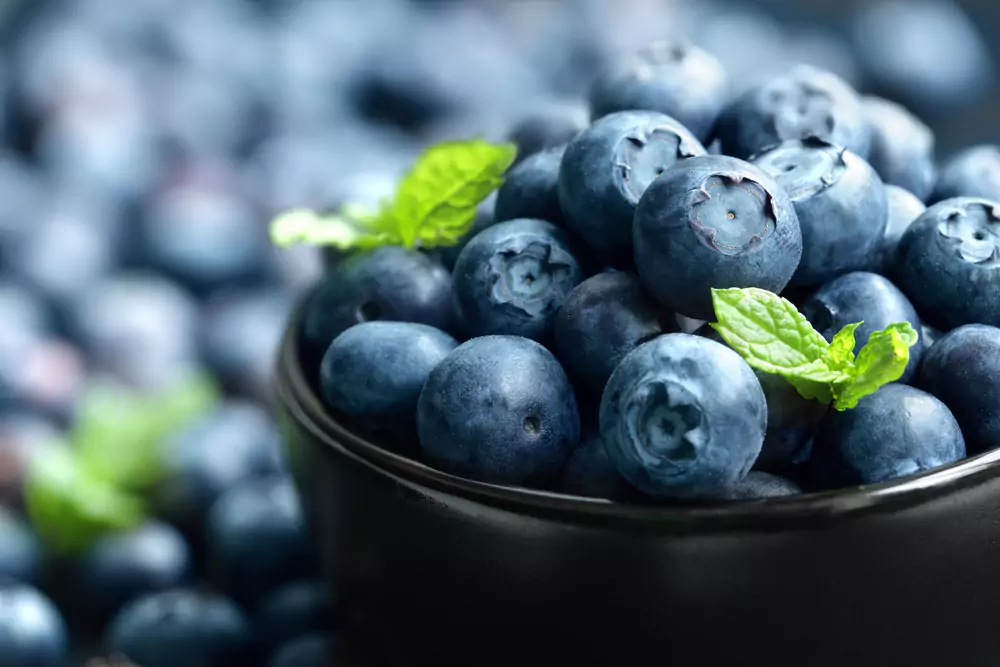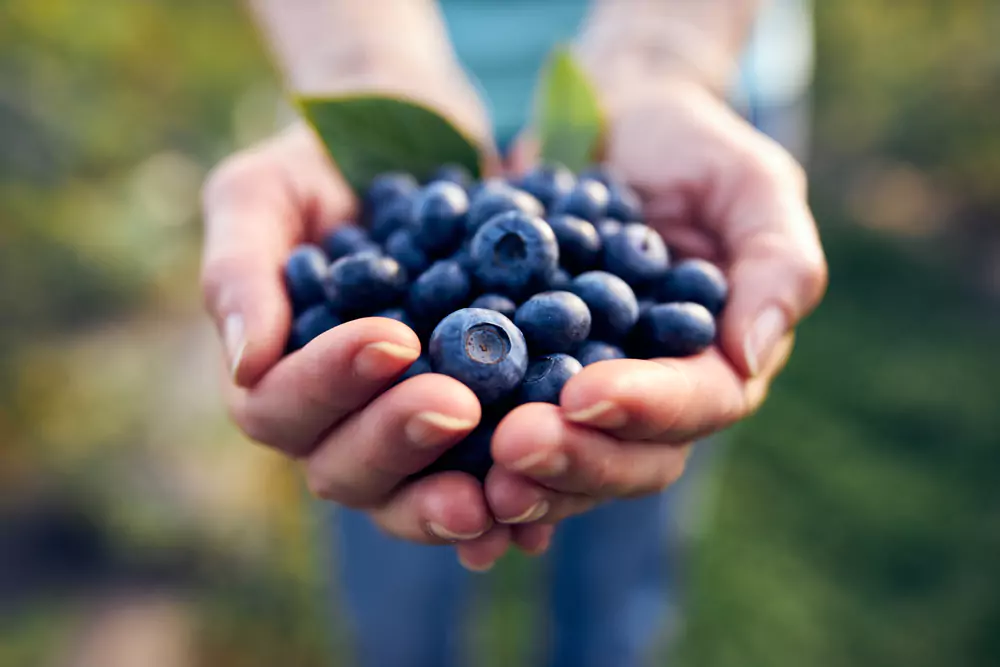As a child, I remember being fascinated by the tiny, blue gems that adorned my morning bowl of cereal. Blueberries, these juicy, sweet, and healthy treats, have become a staple in many households across the globe. However, have you ever wondered ‘’do blueberries have seeds?’’
Blueberries, being a popular fruit, often lead to discussions and debates about their anatomy. Some people argue that blueberries do not have seeds, while others insist that they do. This confusion stems from the unique structure of the fruit, which can sometimes make it difficult to differentiate between the seeds and the fruit’s other components.
To provide a clear and concise answer, we must first understand the anatomy of a blueberry and its various parts. By examining the fruit’s structure, we can determine whether or not it contains seeds.
In this article, I will explore the intriguing world of blueberries, delving into their anatomy and answering the question whether blueberries have seeds or not.
Also Read: 5 Best Blue Vegetables to Put on Your Table
What Are Blueberries?
I absolutely love blueberries! They are small, round, and have a beautiful deep blue color. Blueberries are sweet and juicy, with a slightly tangy flavor. They are often used in baking, smoothies, and as a topping for yogurt or oatmeal.

Blueberries are also packed with antioxidants and are known for their health benefits, such as improving brain function and reducing the risk of heart disease. I enjoy snacking on them straight out of the punnet or incorporating them into my favorite recipes.
Do Blueberries Have Seeds?
In fact, they are an essential part of the blueberry’s reproductive system. When you bite into a blueberry, you may notice the small seeds, but they are soft and easily edible, adding a bit of texture to the fruit.
How Many Seeds Do They Have?
Know that the number of seeds in a blueberry can vary, but on average, each blueberry contains around 50 to 100 small seeds. These seeds are usually very small and not easily noticeable when eating the fruit. However, they are an essential part of the blueberry’s reproductive system and contribute to the plant’s propagation.
Are They Safe To Eat?
You might be concerned ‘’ Are blueberry seeds poisonous?’’ Well, NO! I have found that blueberry seeds are safe to eat. In fact, they are rich in fiber and antioxidants, which can be beneficial for overall health. Personally, I enjoy consuming blueberries with their seeds as they add a slight crunch and texture to the fruit.
However, some people may prefer to avoid the seeds due to their texture or for personal preference reasons. Overall, consuming blueberry seeds is generally considered safe and can contribute to a nutritious diet.
Types Of Blueberries
When it comes to types of blueberries, I have had the opportunity to explore and experience a variety of them. There are several different types of blueberries, each with its own unique characteristics and flavors.

Northern Highbush Blueberries
One of the most common types is the Northern Highbush blueberry. These blueberries are known for their large size and sweet flavor. They are often used in baking and cooking due to their firm texture and rich taste. I have found that these blueberries are versatile and can be enjoyed fresh or used in various recipes.
Southern Highbush Blueberries
Southern Highbush blueberries are another popular type. These blueberries thrive in warmer climates and are known for their high productivity. They have a slightly tangy flavor and are often used in jams, jellies, and preserves. I have personally enjoyed the unique taste of Southern Highbush blueberries, finding them to be a delightful addition to fruit salads and desserts.
Rabbiteye Blueberries
Rabbiteye blueberries are native to the southeastern United States and are well-suited to hot, humid climates. These blueberries have a slightly tart flavor and are often used in baking and making sauces. I have found Rabbiteye blueberries to be delicious when added to smoothies or enjoyed on their own as a healthy snack.
Lowbush Blueberries
Lowbush blueberries, also known as wild blueberries, are smaller in size compared to other varieties. They have a sweet and intense flavor, making them perfect for eating fresh or incorporating into breakfast dishes such as pancakes or oatmeal. I have personally enjoyed the unique sweetness of lowbush blueberries, finding them to be a delightful addition to my morning meals.
How To Extract Blueberry Seeds?
Now that you know whether blueberries have seeds or not, let’s dive into the process of extracting blueberry seeds. Blueberries are an incredibly popular fruit, and understanding how to extract their seeds can be useful for various purposes, such as growing your own blueberry plants or incorporating them into recipes.
Here’s a step-by-step guide on how to extract blueberry seeds:
Collection of Blueberries
First, collect ripe blueberries from a reliable source. It is essential to ensure that the blueberries are organic and free from any pesticides or chemicals.
Washing
Rinse the blueberries thoroughly under cool running water to remove any dirt, debris, or residue.
Drying
Pat the blueberries dry using a clean kitchen towel or paper towel. It is crucial to remove excess moisture to prevent mold growth and make it easier to separate the seeds.
Removing the Seeds
Once the blueberries are dry, you can start removing the seeds. You can do this by gently pressing the blueberries between your fingers, applying slight pressure to crush the fruit and release the seeds. Alternatively, you can use a mortar and pestle or a small food processor to break down the fruit.

Separating the Seeds
After removing the seeds from the fruit, separate them from any remaining fruit pulp and skins. You can do this by sifting the crushed fruit mixture through a fine mesh sieve or a cheesecloth. The seeds will be left in the sieve, while the remaining pulp and skins will be caught in the cloth.
Cleaning the Seeds
Rinse the collected seeds under cool running water to remove any remaining fruit pulp or debris. Drain the seeds and spread them out on a clean kitchen towel or paper towel to air dry.
Storing the Seeds
Once the seeds are dry, store them in an airtight container in a cool, dark place. You can also consider refrigerating the seeds to prolong their shelf life.
How To Use?
Now that you know How To Extract Blueberry Seeds, here are 3 ways to use blueberry seeds:
Planting Blueberry Seeds for a Home Garden
Using blueberry seeds for your home garden can be a rewarding experience. First, gather your supplies, such as a small pot, potting soil, and a spray bottle filled with water. Next, sow the blueberry seeds in the potting soil, making sure to cover them with a thin layer of soil. Keep the soil moist but not waterlogged, and place the pot in a spot that receives partial sunlight. As the seedlings grow, gradually expose them to more sunlight. Once the seedlings are strong enough, transplant them into your garden, ensuring they have enough space to grow.
Germination of Blueberry Seeds for Research or Educational Purposes

Blueberry seeds can also be used for educational or research purposes. To germinate the seeds for these purposes, start by soaking them in a cup of water for 24 hours. After soaking, plant the seeds in a small pot filled with moist, sterilized soil. Keep the pot in a warm and dark environment, such as a plastic bag, to encourage germination. Once the seedlings have sprouted, place the pot in a well-lit area to promote growth.
Blueberry Seed Extraction for Scientific Research
For scientific research, blueberry seeds can be extracted from ripe blueberries. First, wash the blueberries thoroughly, then use a small knife to carefully remove the seed from the fruit. Once the seeds are extracted, they can be used for various experiments, such as studying their genetic makeup or analyzing their nutritional content.
How To Store?
Know that storing blueberry seeds is a simple process that requires a few basic steps to ensure their viability for future planting. Here’s how I store blueberry seeds:
Harvesting the Seeds
When harvesting blueberry seeds, it’s important to select ripe and healthy berries. Once you have gathered the berries, gently crush them to extract the seeds. After extraction, rinse the seeds thoroughly to remove any pulp or residue.
Drying the Seeds
After rinsing, spread the seeds out on a paper towel or a fine mesh screen to dry. Place them in a well-ventilated area away from direct sunlight. Allow the seeds to air dry for approximately 2-3 days until they are completely dry.
Storage Container
Select a suitable storage container for the dried blueberry seeds. A small envelope or airtight container works well for this purpose. Ensure that the container is clean and dry before placing the seeds inside.
Labeling and Sealing
Label the storage container with the date of harvest and the blueberry variety, if known. This information will be helpful when you decide to plant the seeds in the future. Seal the container tightly to prevent moisture from entering.
Refrigeration
Place the sealed container of blueberry seeds in the refrigerator for long-term storage. The cool, consistent temperature of the refrigerator helps maintain seed viability. Avoid freezing the seeds, as this can damage their delicate structure.
How Do You Get Seeds Out Of Blueberries?
Getting seeds out of the blueberries can be a bit time-consuming, but it’s worth it for certain recipes. First, I wash the blueberries and then place them in a bowl. Using a fork, I gently press down on the blueberries and roll them around to separate the seeds from the flesh. The seeds will remain in the bowl while the flesh will stick to the fork.

After repeating this process for all the blueberries, I strain the seeds from any remaining flesh and rinse them with water. This method ensures that I can easily collect the seeds for planting or other uses.
Types Of Berries That Have Seeds
Acai Berries
Yes, acai berries have seeds. These small, round, dark purple berries are known for their high antioxidant content and are commonly found in the Amazon rainforest. The seeds make up a large portion of the berry’s structure and are typically not consumed when the berry is eaten or used in acai-based products.
Aronia Berries
Yes, aronia berries have seeds. Also known as chokeberries, these small, dark berries are native to North America and are often used in juices, jams, and other food products. The seeds are found within the berry and are not typically consumed when the berry is eaten or processed.
Dried Blueberries
Yes, dried blueberries have seeds. Blueberries are small, round fruits that contain tiny seeds within their flesh. When blueberries are dried, the seeds remain within the fruit and are consumed along with the rest of the berry.
Haskap Berries
Yes, haskap berries have seeds. These elongated, deep blue or purple berries contain small seeds within their flesh. Haskap berries are known for their sweet-tart flavor and are often used in jams, jellies, and baked goods.
Hawthorn Berries
Yes, hawthorn berries have seeds. These small, red berries are commonly used in herbal medicine and traditional remedies. The seeds are contained within the berry and are not typically consumed when the berry is used for culinary or medicinal purposes.
Honey Berries
Yes, honey berries have seeds. Also known as sweetberry honeysuckle or blue-berried honeysuckle, these elongated berries contain small seeds within their flesh. Honey berries have a sweet flavor and are often used in jams and preserves.
Juniper Berries
Yes, juniper berries have seeds. These small, dark purple berries are actually not true berries but rather female seed cones of the juniper plant. The “berries” contain seeds within their fleshy scales and are commonly used as a spice in cooking and for flavoring gin.
Gooseberries
Yes, gooseberries have seeds. These small, round to oval-shaped berries contain numerous tiny seeds within their flesh. Gooseberries can be green or red when ripe and are often used in pies, jams, and desserts.
Wild Blueberries
Yes, wild blueberries have seeds. Similar to cultivated blueberries, wild blueberries contain tiny seeds within their flesh. These smaller-sized berries are known for their intense flavor and high antioxidant content.
Conclusion
In conclusion, blueberries do have seeds, but they are very small and not as noticeable as seeds in some other fruits. The seeds are located inside the flesh of the berry and are safe to consume.
Despite their small size, these seeds are an essential part of the blueberry’s reproductive cycle and contribute to the growth of new plants. Understanding the anatomy of blueberries, including their seeds, can enhance appreciation for this delicious and nutritious fruit.
FAQs
Do Berries Have Seeds On The Outside?
Yes, most berries have seeds on the outside. Berries such as strawberries, raspberries, blackberries, goji berries, and golden berries typically have seeds visible on the surface or within their flesh.
Do Strawberries Have Seeds?
Yes, strawberries have seeds. Strawberries contain small seeds both on the surface and within the flesh of the fruit. These seeds are edible and provide essential nutrients and fiber.
Do Raspberries Have Seeds?
Raspberries are known for their numerous tiny seeds. These seeds are what give raspberries their unique texture and are found throughout the fruit’s interior.
Do Blackberries Have Seeds?
Blackberries also have seeds. Blackberries have smaller seeds than raspberries, but they are still noticeable and can be found throughout the fruit’s interior.
Do Goji Berries Have Seeds?
Goji berries contain seeds within their fruit. Goji berries have small, crunchy seeds that are edible and can be consumed whole or separated from the fruit.
Do Golden Berries Have Seeds?
Golden berries have seeds. Golden berries, also known as Inca berries, have small seeds within their fruit. These seeds are edible and can be consumed whole or separated from the fruit.
Are Blueberries Seedless?
Blueberries are considered seedless berries. Although blueberries do contain seeds, they are tiny and not easily visible or noticeable to the human eye.
How Do You Remove Seeds From Blueberries?
To remove seeds from blueberries, you can use a sieve or a fine-mesh strainer. Gently press the blueberries through the strainer, allowing the seeds and any excess juice to be caught by the mesh.
Do All Berries Have Seeds?
Not all berries have seeds. Some berries, such as blueberries and cranberries, are considered seedless due to the tiny size of their seeds or the fact that they are not easily visible.
Do Blueberries Have Iron?
Blueberries contain a small amount of iron, but they are not a significant source of this mineral in the diet. Other iron-rich foods like red meat and leafy greens are more substantial contributors to iron intake.


![Is Sugarcane A Fruit, Vegetable, Or Grass? [ Answered 2024 ] Is Sugarcane A Fruit](https://juicerhunter.com/wp-content/uploads/2023/10/Is-Sugarcane-A-Fruit-150x150.webp)



